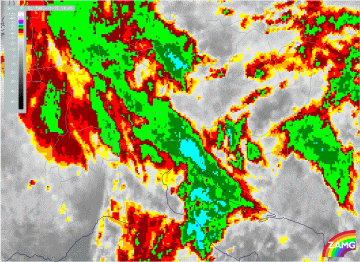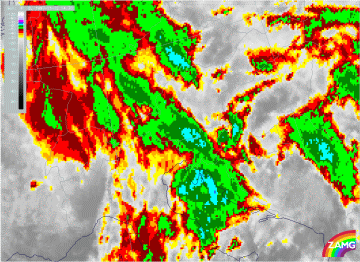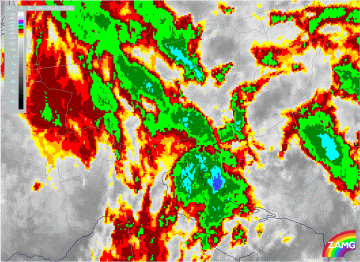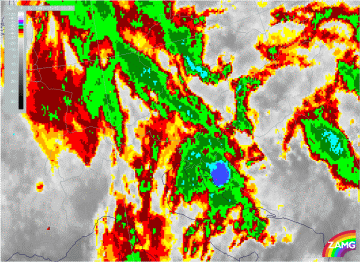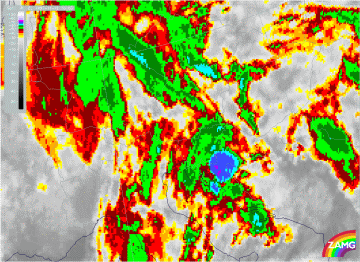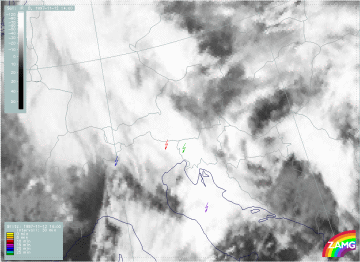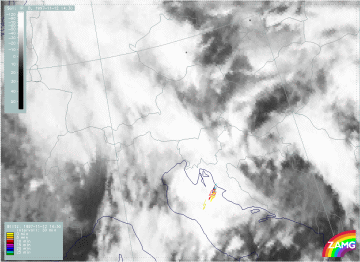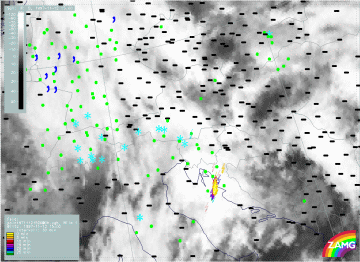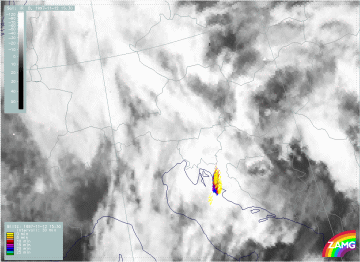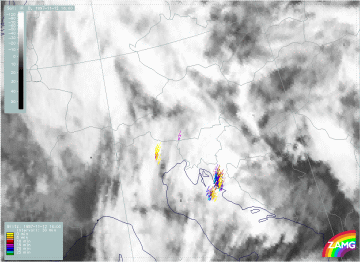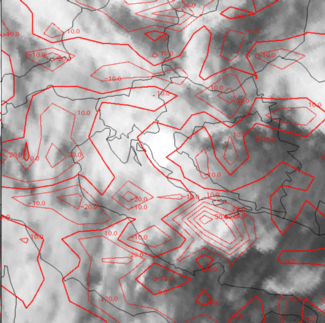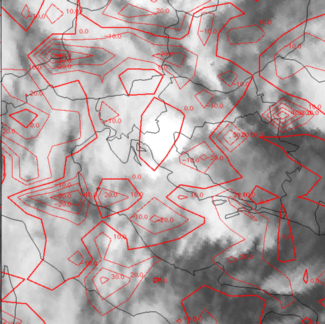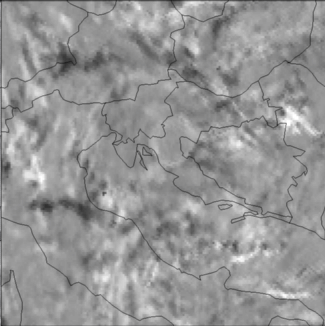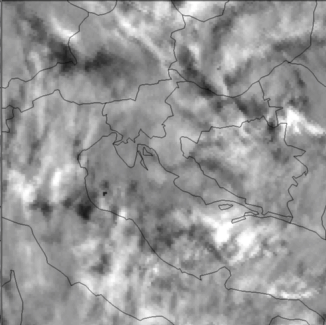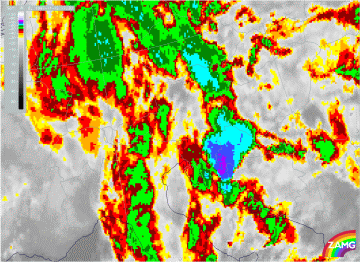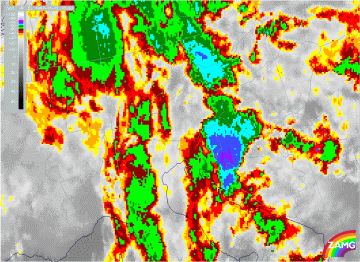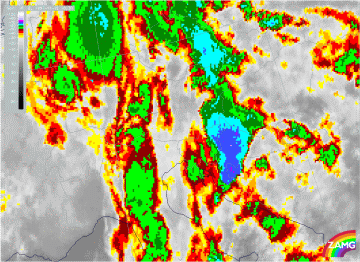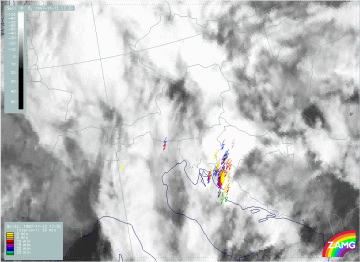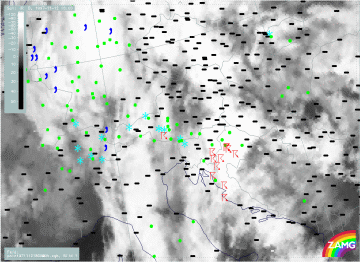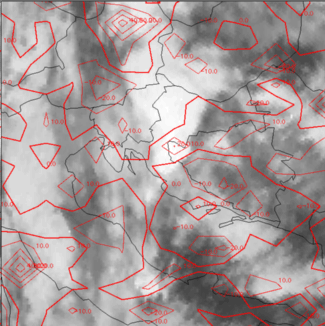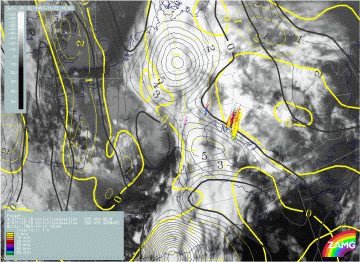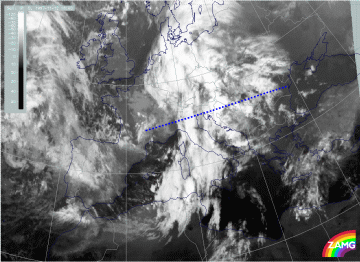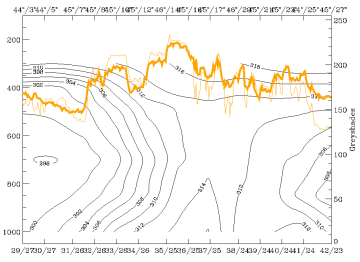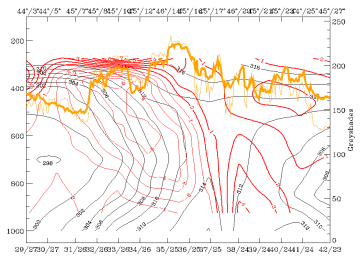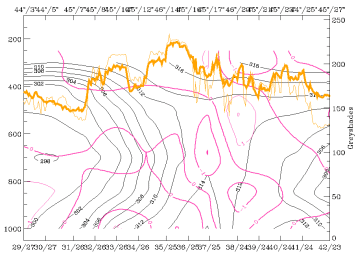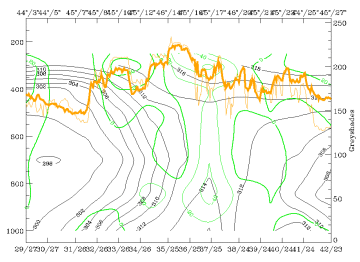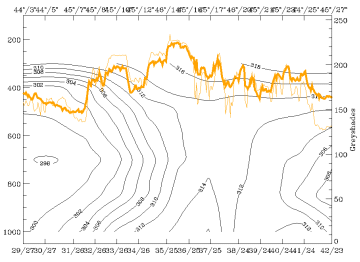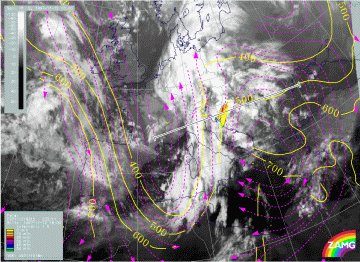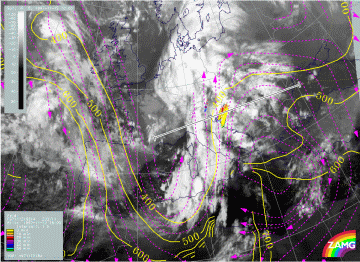The period 12 November 14.00 - 18.30 UTC
Observational part
The period under consideration concentrates on some developments in the area north Adriatic Sea - Croatia - Bosnia - Slovenia which is the thunderstrom complex Th3 from the subperiod before. There are two separate periods with only half hourly time intervals; a fact which has to be taken into account if deviation values or lightning measurements are compared to the other periods based on one hourly intervals.
|
12 November 1997/14.00 UTC - Meteosat IR enhanced image
|
|
The image above can be used to establish the connection to the already discussed MCSs. There is an area of rather broken cloud cells around 46N/16E which is over east Croatia, north Bosnia and north Yugoslavia. This is the rest of the thunderstorm cell Th2, already detected as a fast growing system in the first period from 05.00 - 07.00 UTC over Italy, and again discussed as a fully developed MCS over the Croatian coast and Bosnia in the second period from 09.00 - 12.00 UTC. It has the appearance of a decaying system now.
A second area of interest is the bluish elongated area from south Austria across Slovenia to some parts of Croatia. This is the system Th1 which has been detected in the period 06.00 - 12.00 UTC within the frontal cloud band over north Italy.
A third area can be noticed over the Adriatic Sea around approximately 44N/14E reaching from the Italian to the Croatian coast areas. It has been discussed as a strongly developing MCS Th3 over Italy during the period 09.00 - 12.00 UTC; it will become the most interesting feature for this period.
|
12 November 1997/14.30 UTC - Meteosat IR enhanced image
|
12 November 1997/15.00 UTC - Meteosat IR enhanced image
|
|
12 November 1997/15.30 UTC - Meteosat IR enhanced image
|
12 November 1997/16.00 UTC - Meteosat IR enhanced image
|
The sequence of half hourly enhanced IR images shows the developments from 14.00 to 16.00 UTC. At 14.30 UTC (left image top) the area with the coldest tops of the whole MCS Th3 has moved into the Croatian coast area with some small indication of the development of even colder tops around 44.5N/15E. During the next half hour a distinct development of colder tops has taken place and moved to the Croatian coast area around 45N/15E (right image top). This area broadens at the same location during the next half hour (15.00 - 15.30 UTC, left image bottom) and is shifted somewhat northward till 16.00 UTC (right image bottom) with a second very small cell downstream immediately at the coast. It has to be remembered that the features just discussed are local scale structures within the mesoscale structure of the whole MCS Th3, which covers an area from south-east Austria across Slovenia, Croatia and north Bosnia into the northern Adriatic Sea. The observation will be continued from 17.30 UTC later on.
|
12 November 1997/14.00 UTC - Meteosat IR image; lightning reports
|
12 November 1997/14.30 UTC - Meteosat IR image; lightning reports
|
|
12 November 1997/15.00 UTC - Meteosat IR image; weather reports (green: rain and showers, blue: drizzle, cyan: snow, purple: freezing
rain, red: thunderstorm with precipitation, orange: hail, black: no actual precipitation or thunderstorm with precipitation)
|
12 November 1997/15.30 UTC - Meteosat IR image; lightning reports
|
|
12 November 1997/16.00 UTC - Meteosat IR image; lightning reports
|
|
The sequence of half hourly lightning measurements superimposed on the satellite imagery supports the development of thunderstorms.
For the 14.00 UTC image (left image top) not too many lightning observations took place during the last half hour and the centre of main activity is the huge frontal cloud cell over north-east Italy and Slovenia. This changes dramatically during the next half hour till 14.30 UTC (right image top) where a lot of lightning over the Adriatic Sea is observed exactly where the development of the colder tops of the sub-cell takes place. The same can be noticed for 15.00 UTC (left image middle) and even more intensively for 15.30 (right image middle) where the yellow, actual lightning is observed over the Croatian coast. During the next half hour till 16.00 UTC (left image bottom) the lightning reports remain approximately in the same area and do not move with the coldest tops into the north, north-eastern parts of Croatia. So the lightning remains at the upstream part of this cellular substructure.
|
12 November 1997/15.00 UTC - Meteosat IR image; red: mean values of grey shades of cloud development and decay
|
12 November 1997/15.30 UTC - Meteosat IR image; red: mean values of grey shades of cloud development and decay
|
|
12 November 1997/16.00 UTC - Meteosat IR image; red: mean values of grey shades of cloud development and decay
|
|
The next series of images are the development images which contain the new development and decay of cloudiness in this MCS (Th3). It has to be remembered that the most pronounced development of colder tops within Th3 took place between 14.30 and 15.00 UTC. The first image (left image top) does not reflect this and at first glance even seems to be contradicting it: distinct development took place over the western boundary over the Italian coast and in the central Adriatic Sea while the biggest part of Th3 is under decay, but closer inspection leads to a small area with weak positive values exactly over the developing local scale cell. This shows the weaknesses and difficulties of the development images: one weakness is of course the size of the grid meshes used for the deviation computations; another problem seems to come from the fact that the interpretation of the values of mean deviation is different depending on where the new development happens: if new cloudiness is formed high values of mean deviation appear (this marks the changes from black to white); if cloudiness grows into colder heights, as is the case here, the values of mean deviation are rather small (this marks a change from white to even whiter).
The next two half hour periods are shown in the second image (right image top) and in the third image (left image bottom). The same results can be derived: there is mostly weak decay of cloudiness in the area of the MCS except for a small positive area in agreement with the local scale sub-cell.
|
12 November 1997/15.30 - 16.00 UTC - Meteosat IR development image
|
12 November 1997/15.00 - 16.00 UTC - Meteosat IR development image
|
Another result of this discussion is that the numerical values of deviation (new development) might not be indicative enough in these situations. The images above are the development images themselves with white areas representing new development, black areas decay and grey areas no development of cloudiness. What can clearly be seen in the area of interest is a circular (oval) feature with grey centre and lighter ring-like boundaries. This is a very characteristic feature for thunderstorm cells but for its identification additional methods seem to be necessary, like for instance object recognition methods.
|
12 November 1997/17.30 UTC - Meteosat IR enhanced image
|
12 November 1997/18.00 UTC - Meteosat IR enhanced image
|
|
12 November 1997/18.30 UTC - Meteosat IR enhanced image
|
|
The second half hourly period is between 17.30 UTC and 18.30 UTC. At 17.30 UTC (left image top) the sub-cell has widened and covers north Croatia, east Slovenia and south-east Hungary. A smaller scale cell has developed upstream over the Croatian coast area. Till 18.00 UTC (right image top) a northward movement of both cell centres can be observed which is continued till 18.30 UTC (left image bottom) where for the first time a slight decay can be noticed.
|
12 November 1997/17.30 UTC - Meteosat IR image; lightning reports
|
12 November 1997/18.00 UTC - Meteosat IR image; lightning reports
|
|
12 November 1997/18.00 UTC - Meteosat IR image; weather reports (green: rain and showers, blue: drizzle, cyan: snow, purple: freezing
rain, red: thunderstorm with precipitation, orange: hail, black: no actual precipitation or thunderstorm with precipitation)
|
|
Extended lightning activities are connected with the cell during this period with a concentration upstream at the coast area but extending also north-eastward till the end of the period. Additional to this, lots of thunderstorm reports exist for 18.00 UTC (right image bottom).
|
12 November 1997/18.30 UTC - Meteosat IR image; red: mean values of grey shades of cloud development and decay
|
|
The development image for this last period 18.00 - 18.30 UTC shows the decay in a wide area from east Slovenia and north Croatia to Hungary, but also one area of new development in the upstream part over the Croatian coast area and north-west Bosnia.
Synoptic environment part
For 18.00 UTC the synoptic environment of this MCS Th3 will be investigated. As already noticed in the two earlier periods, the whole area has a high probability for thunderstorm development with values for the Showalter indices <3, partly also <0. In this image the line of the vertical cross section is superimposed which cuts the MCS Th3 under discussion.
|
12 November 1997/18.00 UTC - Meteosat IR image; blue: thermal front parameter (TFP) 500/850 hPa, green: equivalent thickness 500/850
hPa, red: temperature advection 1000 hPa, lightning reports
|
12 November 1997/18.00 UTC - Meteosat IR image; yellow: positive vorticity advection (PVA) 500 hPa, black: positive vorticity advection
(PVA) 300 hPa, lightning reports
|
The image above (left image) shows that this MCS is very close to the Cold Front line (the TFP), especially in the upstream part and TA shows a transition from WA to CA there; this will be discussed in more detail later with help of the vertical cross section. PVA maxima at a height of 500 and 300 hPa (right image) do not show any connection with the Croatian MCS (Th3) but instead coincide with the intensification of cloudiness at the rear side of the frontal cloud band over Italy.
|
12 November 1997/18.00 UTC - Meteosat IR image; position of vertical cross section indicated
|
12 November 1997/18.00 UTC - Vertical cross section; black: isentropes (ThetaE), orange thin: IR pixel values, orange thick: WV pixel
values
|
In the vertical cross section which extends perpendicularly through the Cold Front and the MCS Th3 over Croatia (left image), isentropes (right image) show a distinct frontal crowding zone from 300 - 400 hPa over 44N/06E (south France) down to the surface at about 45N/14E (west Slovenia and west Croatia). As in the periods discussed before, there is a distinct superadiabatic inclination of this surface below 700 hPa. Two maxima of IR and WV signals can be noticed in the frontal area: the more western one over Italy representing the frontal cloudiness and the main maximum representing the MCS Th3 over Slovenia and Croatia.
|
12 November 1997/18.00 UTC - Vertical cross section; black: isentropes (ThetaE), red thin: temperature advection - CA, red thick:
temperature advection - WA, orange thin: IR pixel values, orange thick: WV pixel values
|
12 November 1997/18.00 UTC - Vertical cross section; black: isentropes (ThetaE), magenta thin: divergence, magenta thick: convergence,
orange thin: IR pixel values, orange thick: WV pixel values
|
|
12 November 1997/18.00 UTC - Vertical cross section; black: isentropes (ThetaE), green thick: vorticity advection - PVA, green thin:
vorticity advection - NVA, orange thin: IR pixel values, orange thick: WV pixel values
|
|
The features in the vertical cross section can be summarised as follows:
- Superadiabatic frontal layer below 700 hPa;
- MCS at frontal surface;
- Deep layer of CA connected with cold front surface (left image top); if at all WA only in very low layers; this is different from all the other convective cells described till now where there was WA, at least in a low to middle layer;
- Although convergence (right image top) is rather weak in the area of the thunderstorm reports there is notable convergence in front of the frontal surface over approximately 45N/17E over east Croatia; a thick pre-frontal convergence layer was one feature common to the thunderstorm cells discussed so far;
- Increase of PVA with height (left image bottom) is connected with the western maxima of satellite signals and has nothing to do with the MCS Th3 under consideration.
|
12 November 1997/18.00 UTC - Vertical cross section; black: isentropes (ThetaE), orange thin: IR pixel values, orange thick: WV pixel
values
|
|
Although relative streams might be difficult to interpret in the frontal area because of the steep and partly also superadiabatic inclination, they are of major interest. Therefore two surfaces are chosen:
- ThetaE 312K is on top of the frontal surface and can be followed in the area of the frontal convective feature Th3 down to 500 hPa;
- ThetaE 314K is an undisturbed surface immediately above and indicates a layer between 300 and 450 hPa.
|
12 November 1997/18.00 UTC - Meteosat IR image; magenta: relative streams 312K - system velocity 232° 11 m/s, yellow: isobars,
lighting reports; position of vertical cross section indicated
|
12 November 1997/18.00 UTC - Meteosat IR image; magenta: relative streams 314K - system velocity 232° 11 m/s, yellow: isobars,
lighting reports; position of vertical cross section indicated
|
The ThetaE surface of 312K (left image) shows in the area of the MCS Th3 a relative stream typical for the Warm Conveyor Belt, while the upper relative stream from behind the front can already be identified over Italy. On the ThetaE surface of 314K (right image) the upper relative stream from behind is shifted more to the east and therefore already within the MCS Th3. This is a vertical distribution of relative streams typical for the leading part of a frontal situation and characteristic for an unstable vertical stratification there.
